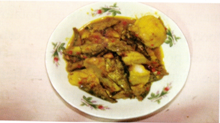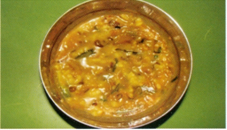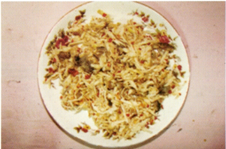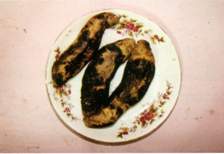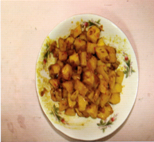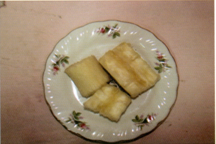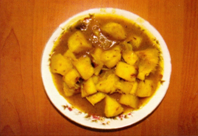Traditional Tuber Crops Based Foods
In general, tuber crops are consumed in four forms such as (i) boiled tuber along with tea as breakfast or snack, (ii) vegetable currys using fresh vegetables / plant parts and consumed along with rice, and (iii) vegetable currys using semi-processed tuber crops products and consumed with rice, (iv) porridge or roti prepared from the flour of tubers. Though, there are variations among the preparations of various tribes, this consumption pattern is widely followed across tribes. Various traditional tuber crops recipes documented from Manipur are described below.
Manipur
Meitei community
Pan iromba (Taro chutney) Pan iromba is a popular traditional dish of Meitei community that find a special place in marriage ceremonies and festivals. For preparing pan iromba, skinned and cut taro tubers are steam-boiled with red chilies for 20 minutes. Then cooked taro tubers are mashed and kept in a vessel. Boiled chilies are also mashed to become thick liquid and added to taro and mixed thoroughly. Fermented fish is roasted on flame, mashed and added to taro mix. Then salt is added and mixed thoroughly. The alium sprouts are cut into small pieces and spread on the mix for serving with rice.
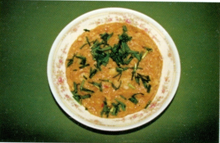 |
Pan thongba (Taro curry)
Skin-removed taro tubers are boiled with fermented soybean (Hawaijar) which is then mixed with roasted fermented fish (Akangba). Onio, chili and salt are added and mixed thoroughly (fig.2) and consumed with rice.
Uti curry
Boil blackgram seeds, skin-removed taro tubers/peas/vegetables and Soda salt in water for 20 minutes. Fry onion, red chilies, ginger in oil and add them with black gram mix and make them as paste (Fig.3). This is consumed along with rice.
Hawaijar Pan Thongba (Fermented soybean)
The taro tubers are skin-removed and steam boiled for 20-30 minutes. Onion, cumin and Hawaijar (fermented soybean) are fried in mustard oil, when they turn brown the turmeric powder and red chilli powder along with salt are added and mixed thoroughly. Then boiled taro tubers and fried materials are mixed thoroughly by adding water till they are blended thoroughly (Fig.4)
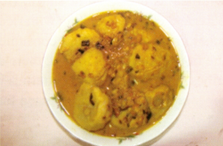 |
| Hawaijar Pan Thongba (fermented soyabean) |
Shingzu (Yendem Maru)
Shingzu is a salad type dish prepared from swamp taro tubers. The skin-removed tubers are grated into fine pieces. The red chilli powder, roasted nari (dry fish), Bengal gram flour, boiled chawai (rice bean) are mixed with grated tubers (fig.5). Shingzu is consumed along with rice and as snack during evening along with tea.
Mangra Larba (Boiled sweet potato)
During winter, the Meitei people consume mangra larba (boiled sweet potato) as a snack food along with black tea. The fresh red skinned sweet potato tubers are washed and kept inside the charcoal during cooking. After completion of cooking, roasted tubers are removed from charcoal, cleaned and consumed (Fig.6).
Ha Thongba, U-Mangra thongba and U-Mangra Phutpa
Ha thongba and U-Mangra Thongba are prepared from cassava tubers. Ha thongba is prepared by frying skin-removed and cut cassava tubers in oil and mixing turmeric powder, red chilli powder, salt and other spices. U-Mangra thongba is prepared in the same by by using boiled cassava tubers. Both Ha Thongba and U-Mangra thongba are consumed along with rice during breakfast and dinner. U-Mangra phutpa is a steam-boiled cassava tuber consumed as snack with tea. The photographs of these dishes are given Fig.7
Ha Thongba |
U-Mangra thongba |
U-mangra phutpa |
Paite community
Boiled tubers
Cassava and yams are skin-removed, cut and boiled in water for 20-30 minutes till the flesh becomes soft and eaten as snack during lunch time along with black tea. This form of consumption is found when tubers are available, immediately after harvest. During summer, the boiled tubers are consumed within 3 hours of cooking while in winter, they can be stored for one day without spoiolage. Soft mature cassava leaves are cut into pieces and cooked along with meat (pork/chicken/fish) and eaten. Bal punhuan is a boiled taro tuber which is consumed as snack during noon.
Dolhou
Dolhou is a dried taro petiole and leaves, which is prepared in June-July and stored for consumption for a year. (Fig 8) The taro petioles with leaf are cut into two halves and sundried till they become dark in colour. Then they are rolled as balls, wrapped in a paper or hanged from rooftop using threads. Dolhou is used in several recipes like soups, dolhou maltame
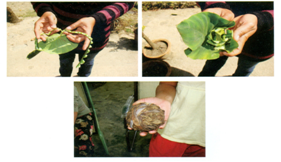 |
Steps in preparation of Dolhou |
For preparing Dolhou maltame, the dolhou is cut into small pieces, boiled with red chilli for 20 minutes. Then fermented fish (Ngathu/Ngari) is roasted for 3 minutes, added to the boiled dolhou and the mix is thoroughly mashed. Salt and coriander/alium leaves are added to make the dish delicious. It is consumed along with rice during breakfast and dinner. Dolhou is also cooked with chicken/pork.
Uti chutney
In Uti chutney preparation, potato/taro tubers are skin-removed and boiled along with red chilies for 20 minutes. Boil broad bean/tree bean seeds and grind them to make a mash. After boiling the taro tubers and red chillies mashed in separate containers and mixed together. The fermented fish is roasted for 3 minutes, mashed and added to broad bean and taro and mixed thoroughly. Sometimes, the cut and boiled dalhou is also added with this chutney. It is served with rice during breakfast and dinner. Few affluent families use Goluaithu (fermented bamboo shoot) with this recipe. This Uti chutney is consumed throughout the year.
Kolkai Hou
The fresh sweet potato tubers are washed and cut into small pieces and sundried for two days. These chips are stored in perforated containers for 6 months.Kokai hou is a dish prepared by boiling Tuaiki leaves, dried sweet potato chips along with rice for 20-25 minutes. The boiled mix is mashed and eaten during noon. Tea is not consumed along with this dish.
.Changem pomba
Chengam Pomba (Rice porridge) is a popular traditional food of Manipur. It is prepared by mixing half boiled rice with cooked vegetables/mustard leaves/bean leaves/ dolohou/ridge gourd and mashed till it becomes a porridge like substance.
Hakai Kan
Skinned, cut pieces of Hakai (yam) of 10 cm thickness are fried with onion and turmeric and salt are added. Then water is added and boiled for few minutes. This dishes consumed with rice during breakfast and dinner.Cut hakai pieces are also fried with mustard leaves, onion and water is added and boiled for few minutes.In wealthy families, they cook yams with dry fish and rice and used as snack food along with rice.
Bal Kan (Fried taro)
Skin-removed taro tubers are cut into pieces and fried with lemgmasel tree flowers till they become brown and water is added and kept for boiling for few minutes. Bal kan is eaten with rice during breakfast and dinner.
.Monglok curry
Manglok (Ficus spp.) flower buds are cooked with cut taro tubers and dried fish and eaten. This recipes prepared mostly during Feb-March during the flowering season of Ficus.
Kuki community
Hinjang (Big taro)
Hinjang is a curry prepared by boiling skin-removed taro tubers with mustard leaves in water for 20 minutes. After cooking. Roasted dry fish (Nari), boiled red chillies and salt are added and stirred thoroughly. It is consumed along with rice.
Manga Anganba
Rice is boiled in water for 15-20 minutes and then the water is drained partially and sweet potato is removed and consumed separately during breakfast and dinner.
Palu-kabi Shi Shingzu
It is a salad food prepared from the tubers of swamp taro. The swamp taro tubers are cut into small pieces and mixed with sliced raw papaya fruits. Pea powder/ besan and till seed powder, ground red chilli and dried fish are mixed together thoroughly and consumed as salad along with rice and also consumed as snack along with tea in the evening.
Palu-Kabi Curry
It is prepared by frying chopped swamp taro tubers in oil and adding chilli, turmeric powder, salt, spices. Add water after the mix is fried thoroughly.In another form of curry, palu-kabi is sliced into pieces, boiled in water and mixed with roasted fermented fish. Then onion, spices, salt and coriander leaves are added and mixed thoroughly.
Mangra with Jaggery
Mangra (cassava tubers are boiled in water for 10-15 minutes. When they are half cooked, jaggery is added and boiled till the mix becomes stickly. It is consumed as snack food along with tea/milk.
.Maring community
Pan Thongba (Taro curry)
Skinned taro (big sized corms) are cut into pieces and boiled in water for 15-20 minutes. Then Hawa Achar (Fermented soybean) is added into it along with spiced, red chillies, salt and boiled till they are properly cooked. It is served as curry along with rice.
Pan Arouba
Swamp taro tubers are cut into big pieces and kept below burning charcoal. When they are properly cooked, they are cleaned and consumed as snack food along with tea.
Chagem Pomba
It is a famous dish of Meitei and Maring communities of Manipur and important dish in Marriages and festivals. The washed, skinned taro is cooked with dry meat (pork/beef) and or dry fish. After proper cooking turmeric powder, ginger, powdered red chillies and salt are added and stirred.
Hing Kharabak
Red skinned sweet potatoes are washed and steam cooked in a special container for 30 minutes. When cracks appear on the tubers, they are removed from the container and consumed as snack food with tea or milk.
U-Mangra Roti
The cassava tubers with pink coloured rind are skin-removed, sliced into thin pieces and sun dried for 3-4 days. The dried slices are then finely ground in the wooden grinder and the flour is stored in air tight containers for 2-3 months. The flour is then used to prepare rotis. This product is widely consumed by the wealthy section of the community.
Source:
Traditional Tuber Crops of North-Eastern India
Dr.P. SethuramanbSivakumar, et.al
Central Tuber Crops Research Institute (CTCRI)
Sreekariyam, Thiruvanathapuram
Kerala
| 

